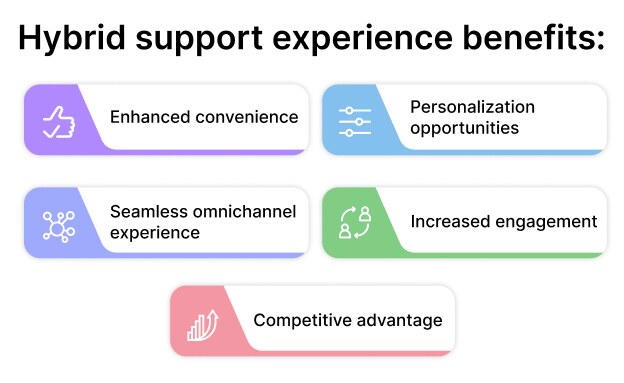 Customer Service
Customer Service

31 December, 2023

Customer service is the backbone of any successful business. It’s the key to building strong relationships, fostering loyalty, and ensuring customer satisfaction. Using hybrid technologies for customer service The work was done alternating between the workplace and home.
Does improving the experience through this help the customer service departments? It does, of course. If it’s properly arranged, hybrid customer service offers businesses the opportunity to elevate the customer experience by combining the best aspects of digital and traditional channels.
Hybrid customer service breaks through channel barriers, weaving together technology and human interaction to create a seamless, continuous experience that wows your customers.
In this blog, we will expand on how hybrid customer service enhances the customer experience.
Contents
Hybrid customer service is about finding the right balance between automation and human interaction. Hybrid customer service is a model that blends the best of traditional, in-person customer service with the efficiency and flexibility of digital, remote support in the customer service industry.
Hybrid customer service empowers businesses to deliver exceptional customer experiences by combining the strengths of humans and AI technologies
Hybrid customer service! It’s a blend of traditional in-person touch with the efficiency and convenience of online platforms.
By integrating virtual tools with human expertise, hybrid customer service offers several benefits. It enables 24/7 availability, as self-service options and automated systems can assist outside of traditional business hours. Scalability is possible with online tools because they can manage large volumes of requests, freeing up staff to work on more specialized projects.
Customers can choose their favorite route—phone, email, social media, even in-person visits—while AI chatbots and self-service platforms handle the routine tasks, freeing up agents for personalized attention and live chat customer service. This hybrid approach sources both customer happiness and employee satisfaction and shows how to improve customer service skills.

Hybrid customer service takes the best of both worlds—the efficiency of technology and the empathy of human interaction—to create a truly exceptional customer experience.
As per Forbes, “customer experience is today’s business benchmark.”
Improving the customer experience across all touchpoints is one of the first steps you can take to establish a strong customer experience strategy.
Let’s explore the specific ways it enhances the customer journey:
Digital tools such as chatbots and self-service portals enable round-the-clock support. Customers can find answers to common questions or initiate basic interactions outside of traditional business hours.
You can instantly engage with customers with live chat and respond to their queries. Connecting with customers right away reduces the number of issues and improves the resolution time. This 24/7 availability ensures that customers can receive assistance whenever they need it, increasing convenience and reducing frustration.
Hybrid customer service allows them to find solutions on their own through self-service options, which enhances their customer service. Knowledge bases, FAQs, and video tutorials can be easily accessed through digital platforms, enabling customers to fix issues independently.
This self-service capability reduces dependency on support agents for minor concerns, giving customers more control and saving time for both parties.
By combining human interaction with customer service bots, businesses can deliver highly personalized support. Agents have access to customer data and history, allowing them to understand individual preferences and provide tailored assistance. By providing thank-you letters or emails to customers after purchase, this personalized approach makes customers feel valued and understood, leading to a more satisfying experience.
The integration of AI tools in a hybrid customer service approach facilitates continuous improvement. Data and analytics collected from various touchpoints provide valuable insights into customer preferences, pain points, and trends.
Businesses can leverage this information to identify areas for improvement, optimize processes, and enhance the overall customer experience.
Improved customer service efficiency is crucial since it reduces reaction times to client issues, and prompt resolution may greatly boost customer satisfaction. Chatbots can handle routine inquiries and provide instant responses, freeing up human agents to focus on more complex or specialized cases.
Automated ticketing systems ensure that customer inquiries are directed to the right department or agent, reducing wait times and improving overall efficiency.

A hybrid customer experience refers to combining both digital and in-person interactions to create a seamless and personalized customer journey.
Here are five reasons why you need a hybrid customer experience:
A hybrid customer experience offers enhanced convenience by providing customers with multiple touchpoints to interact with your brand. This convenience is crucial in today’s fast-paced world, where customers expect seamless access to products and services.
Whether through your website, mobile app, social media platforms, customer service in healthcare, or in-person interactions, engaging with your brand at their preferred time and place increases customer satisfaction and loyalty.
A hybrid customer experience allows for personalized interactions with customers. By collecting data from various touchpoints, such as purchase history, browsing behavior, and demographics, you can gain insights into individual customer preferences and tailor their experience accordingly.
Personalization can range from recommending relevant products and sending targeted offers to customizing communication and content. This level of personalization creates a deeper connection with customers and increases their engagement with your brand.
One of the key advantages of a hybrid customer experience is the ability to provide a consistent omnichannel experience. A multichannel approach ensures that customers can start their journey on one channel and smoothly transition to another without any interruption.
For example, they may research products online, add items to their cart, and then choose to complete the purchase in-store. This seamless integration between digital and physical touchpoints eliminates friction and enhances the overall customer experience.
Hybrid customer service statistics boost customer engagement by utilizing both digital and in-person touchpoints. Digital platforms allow for proactive engagement through email marketing, social media campaigns, chatbots, and personalized content.
In-person interactions, however, create a more personal and human connection, fostering trust and loyalty. By effectively combining digital and physical touchpoints, you can engage customers at different stages of their buying journey, nurture relationships, and drive repeat business.
Adopting a hybrid customer experience gives you a significant competitive advantage in the market. Customers today expect smooth integration between digital and physical channels, and delivering this experience sets you apart from competitors who may still operate in silos or focus on only one channel.
Providing a convenient, personalized, and seamlessly connected customer journey differentiates your brand and attracts new customers while increasing loyalty among existing ones.
Implementing hybrid customer service needs careful planning and execution. Here are some customer service tips to help you successfully implement them in your customer support operations:
Hybrid customer service offers several benefits that can transform your customer experience:

While a hybrid customer service model offers numerous advantages, it also presents unique challenges that need to be addressed for its successful implementation. Here are some key challenges and potential overcomers.
The future of hybrid customer service looks promising, with advancements in technology and evolving customer expectations. Here are some emerging trends to watch for:
Example 1: Amazon’s hybrid customer service strategy: Amazon is renowned for its customer-centric approach and its use of hybrid customer service. Through a combination of AI-powered chatbots, self-service options, and human agents, Amazon provides fast and efficient support while maintaining a personalized experience for its customers.
Example 2: A case study of a company that improved the customer experience through hybrid customer service: [company name], a leading e-commerce platform, implemented a hybrid customer service approach. By integrating live chat support, self-service resources, and a dedicated team of customer service representatives, they were able to reduce response times, increase customer satisfaction, and improve the overall customer experience.
Hybrid customer service is the future of customer support, enabling businesses to provide personalized and efficient support while optimizing resources and gaining valuable insights into customers’ needs. With careful planning, training, and optimization, implementing hybrid customer service can significantly enhance the overall customer experience and drive business success.
It’s time for businesses to embrace this innovative approach and stay ahead in today’s competitive marketplace. So, let’s explore hybrid customer service together and take our customer service efforts to the next level! Incorporate hybrid customer service into your strategy today and see the positive impact it has on your customers and business.